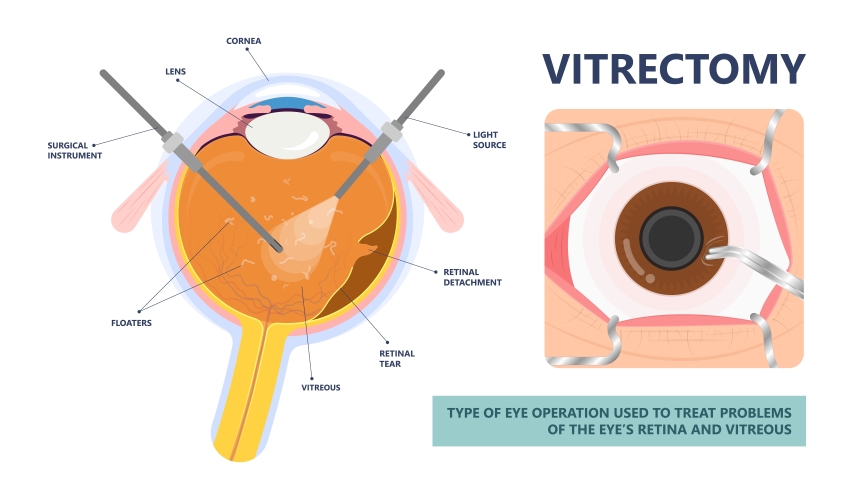What is Vitrectomy (Retina Surgery)?
Vitrectomy (Retina Surgery) is the process of separating and cleaning the transparent and jelly-like liquid called vitreous, which fills the space in the large area at the back of the eye, from where it is located.
The vitreous is the fluid that keeps the eye as an anatomical whole. It is also the part of this fluid that provides the main vision function and sends neural messages to the brain.
Evacuation of vitreous fluid provides the vitreoretinal surgeon with access to the retina and its pathologies. After the fluid is drained, the same fluid does not occur again. On the other hand, after the surgery, liquid, air, gas or silicone is left in the eye and the liquid produced by the eye itself replaces the substance left in the eye over time.
After the fluid is drained, its place is filled with aqueous humor. Many diseases that are thought to be incurable are treated with this surgical method. However, blindness is prevented.
What is The Purpose of Vitrectomy?
Vitrectomy operation can be performed for the purpose of cleaning intraocular hemorrhages, surgical removal of scar tissues and relieving retinal (nerve network layer of the eye) shrinkage. Bleeding, inflammatory cells and scar tissue impair vision by preventing the image from reaching the retina where it is perceived. In addition, if the vitreous gel creates shrinkage on the retina and impairs its function, this should be corrected with vitrectomy.
In Which Eye Diseases Is Vitrectomy Applied?
There are many reasons for vitrectomy.
The most important indications:
- Diabetic Retinopathy (Advanced Pathologies in Diabetics)
- Vitreous Bleeding (Intraocular Bleeding)
- Macular Hole (Hole in Center of Vision)
- Macular Pucker (Wrinkle in the Center of Vision)
- Retinal Detachment and Tears (Rupture of the Neural Network Layer of the Eye)
- Preretinal Membranes (Membranes Formed in the Neural Network)
- ROP (Retinopathy of Prematurity that Can Be Seen in Babies Staying in an Oxygen Tent for a Long Time Due to Premature Birth)
- Complication of intraocular lens remnant after cataract surgery
- Endophthalmitis (Intraocular infections after cataract and other eye surgeries)
- Treatment of eye injuries and removal of intraocular foreign body
How is Vitrectomy Surgery Performed?
Vitrectomy surgery is an outpatient procedure. So the patient does not need to stay in the hospital. If there is no special situation, the patient is discharged on the same day. In most patients, regional (local) anesthesia applied to the corner of the eye is sufficient. General anesthesia can be applied in pediatric patients, panic attack patients, eye traumas or operations that are expected to take a very long time.
Before starting the operation, the eye is wiped and covered in a sterile manner. Then, with very thin instruments, 3 incisions of approximately 1 mm are made in the white part of the eye just behind the pupil and the operation is started.
First, the vitreous gel is removed. Then, the treatment of diseased tissues such as tears, holes, membranes in the retina is performed. If necessary, laser treatment is applied. At the end of the operation, liquid, air, gas or silicone is left in the eye.
The fluid produced by the eye itself replaces the substance left in the eye over time. This is 1 week for air, 2-8 weeks for gas. Silicone, on the other hand, does not disappear in the eye and requires a second surgery to be removed.
How is Seamless Vitrectomy Surgery Performed?
Thanks to microsurgical devices and instruments developed in recent years, seamless vitrectomy surgery is possible.
- 23-scale (0.64 mm diameter)
- 25-gauge (0.5 mm diameter) and
- 27-scale (0.42 mm diameter)
microsurgical instruments can be used. Since the dimensions of these microsurgical instruments are very small, it is not necessary to suture the holes opened in the eye.
What are The Advantages of Seamless Vitrectomy?
- Complications related to sutures are eliminated,
- There is no feeling of stinging due to stitches,
- Patient comfort increases.
- Since the conjunctiva does not open, the risk of dryness is reduced in patients with corneal or conjunctival disease such as dry eye.
- The operation time is shortened.
What Are The Risks of Vitrectomy?
This type of surgery gives very successful results. On the other hand, it certainly carries some risks.
These risks are rarely encountered.
- Intraocular Bleeding
- Eye Infection
- Cataract Development (Most Common)
- Raised Intraocular Pressure
- Light Damage to the Retina
- Tear in Retina
Things to Consider Before Vitrectomy Surgery
Before surgery, your ophthalmologist will perform a detailed examination of your eye. These examinations are performed by methods such as OCT, retinal ultrasound, slit lamp examination, and fluorescent angiography. If the operation will involve the anterior region, additional examinations may be required.
Before the operation, the ophthalmologist can give the patient certain recommendations that should be followed. These may vary from patient to patient.
Your ophthalmologist usually asks the patient not to eat or drink anything 8 hours before the surgery. Again, as a result of various tests, he may ask you to stop using the medication on the day of surgery.
When Is Vision Recovery After Vitrectomy Surgery?
Vitrectomy is the most difficult operation for ophthalmologists to predict postoperative vision. If there is a systemic (such as diabetes and hypertension) or any eye disease affecting the vitreous and retina, various treatments such as medication or laser are applied, but if the disease progression cannot be stopped, Vitrectomy surgery is applied to the patients. Unfortunately, artificial intraocular retina has not been produced with the technology reached by current medical science. As a result, retinal tissue that is damaged, previously injected with laser, needles or traumatized during surgery is tried to be repaired. In other words, as it can be understood, tissue repair is performed with vitrectomy surgery, not tissue replacement. The anatomical success of the surgery is to reach these determined goals.
Functional success, that is, the level of vision that can be achieved in the retina (net layer) that has nerve tissue and is not regenerated, can only be determined after a certain period of time. Of course, these results are also related to how sensitive structures that enable vision are affected before the operation. If the previous damage is small, the increase in vision after the surgery is very high, and if the effect is high, the increase in the visual level is less.
What Should The Patient Pay Attention To After Vitrectomy Surgery?
- After the operation, the eye should remain closed until the first control, unless otherwise stated. (You can buy clean closure cotton and bands from the pharmacy and change them daily)
- Eyes should not be touched by water for one week (unless otherwise told); the head should be washed from the back and the body should be washed separately so that water does not get into the eyes. Eyes should be thoroughly cleaned with wet cotton. After completing a week, you can take a shower with your eyes closed and without rubbing.
- Eye wipes, paper towels, etc., which are not clean. should not be deleted.
- No pressure should be applied to the eye.
- While being discharged, the doctor should be informed about which drugs should be used, if drops are given, how many times a day and for how long.
- Some stinging and pain in the eye (responsive to painkillers) may be considered normal after discharge.
- Head position is important after the operation. It should be learned from your doctor how and for how long to lie down, and care should be taken to stay in the recommended position.
Pay Attention To The Following İf Gas İs Given To The Eye During Vitrectomy Surgery
- If gas is given to the eye after the fluid is drained, the vision will decrease slightly after the operation.
- This takes between 2-6 weeks.
- For this reason, it is forbidden to board a plane or drive a car for the first month and a half after the operation in people who are given gas in the eye.
- On the other hand, people who need to undergo another operation by taking anesthesia after this operation should definitely inform their doctor that there is gas in the eye.
Pay Attention To The Following If Silicone Is Left In Vitrectomy Surgery
- Sometimes in some surgeries, silicone is deliberately left inside the eye.
- This leftover silicone stays in the eye for a minimum of 3, a maximum of 6 months.
- After a maximum of 6 months, the silicone is removed because the cyclone becomes milky after a while, that is, it may deteriorate. In this case, it begins to hurt the eye.
- May cause eye pressure. For this reason, the silicone must be removed with a second surgery after a maximum of 6 months.






